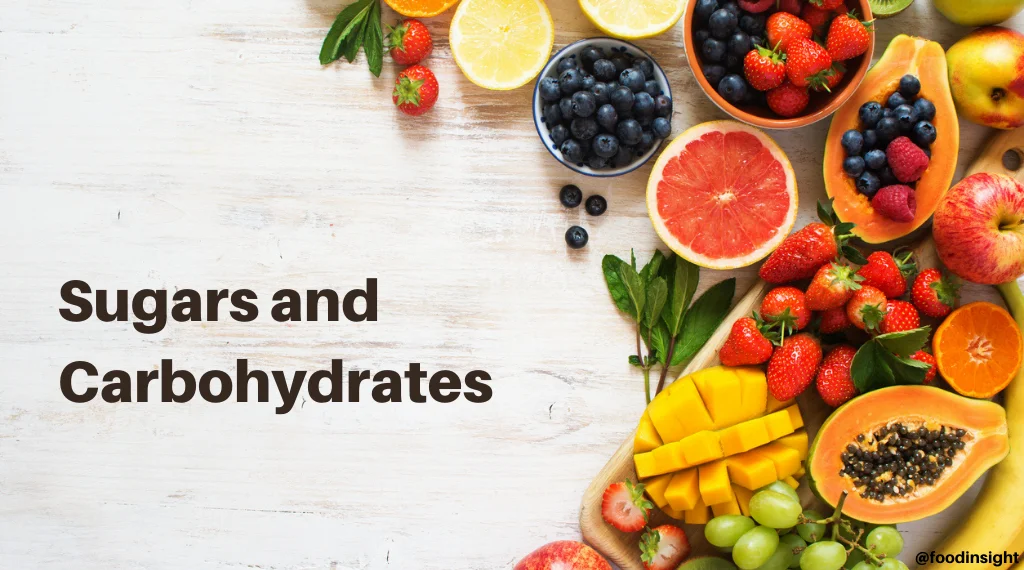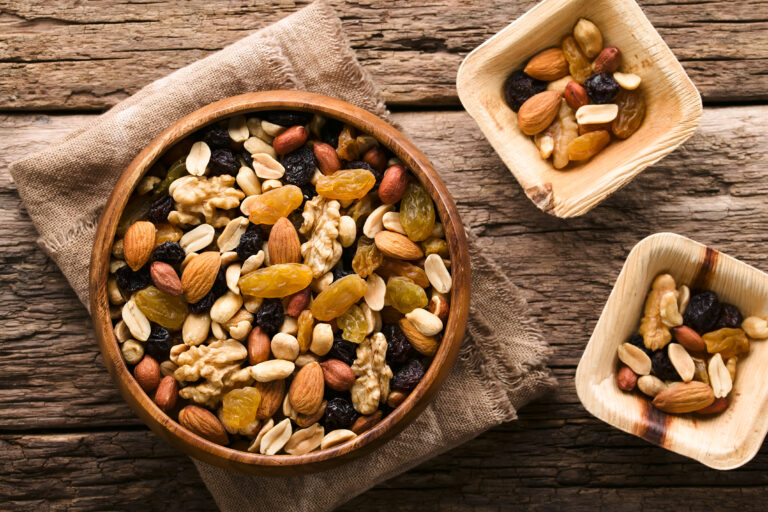
This article provides an overview of how carbohydrates and sugars are classified, common types that are found in foods, their impact on health and what the latest dietary guidance recommends about their consumption.
Carbohydrates are one of the three basic macronutrients needed to sustain human life—the other two are fats and proteins. Carbohydrates encompass a broad range of fibers, starches and sugars. Foods that contain carbohydrates provide a variety of other important nutrients to the diet (such as vitamins, minerals, phytochemicals and antioxidants). Carbohydrates occur naturally in whole foods such as fruits, vegetables, grains and dairy products. Carbohydrates are in most packaged foods as well.
Carbohydrate classification
The basic building block of a carbohydrate is a simple union of the elements carbon, hydrogen and oxygen (CHO). The chemical definition of a carbohydrate is any compound containing these three elements which typically has twice as many hydrogen atoms as carbon and oxygen atoms (CH2O). Some types of carbohydrates may have more carbon atoms than oxygen atoms, but all carbohydrates will have twice as many hydrogen atoms as oxygen atoms (CxH2yOy).
There are three classifications of carbohydrates: sugars (these include monosaccharides and disaccharides), oligosaccharides and polysaccharides. Saccharide originates from the Greek word for sugar, “sákkharon.” Mono-, di-, oligo- and poly- refer to the number of sugar units present in a carbohydrate.
Sugars in foods
When you hear the word “sugar,” you likely think of the white granulated version found in sugar bowls and tabletop packets. That type of sugar is called sucrose. But there are many other types of sugars, all of which scientists classify according to their chemical structures.
Simple sugars are called monosaccharides; these are made up of single sugar molecules. The three main monosaccharides that we consume are fructose, galactose and glucose. These monosaccharides combine in various pairs to form the three disaccharides that are most important in human nutrition: lactose, maltose and sucrose. The monosaccharide glucose is the common thread in each of these disaccharides. Glucose is part of sucrose (linked with fructose), lactose (linked with galactose), and maltose, which consists of two linked glucose molecules. Starches and fibers in foods are made up of many simple sugars that are bonded together.
Sugars occur naturally in a wide variety of fruits, vegetables and dairy foods. Sugars are also produced commercially and added to foods as an ingredient that provides various technical functions, including contributing to a food’s structure and texture, adding sweetness and flavor enhancement, balancing acidity, controlling crystallization in confectionaries, providing a medium for the growth of yeast in baked goods and preventing spoilage by binding water to reduce its activity.
Whether sugars are natural or added, most contain approximately four calories per gram. Here are some types of sugars that are found in whole and packaged foods:
- Allulose: A type of rare sugar that is found naturally in small quantities in brown sugar and maple syrup, as well as in dried fruits such as figs and raisins. Allulose contains 90% fewer calories than sucrose. It may also be commercially produced from fructose or corn.
- Corn syrup: Made from corn and usually 100% glucose, corn syrup is different from high fructose corn syrup (HFCS).
- Fructose: Sometimes called “fruit sugar,” fructose is found primarily in fruits, but also naturally occurs in vegetables, honey, sugar beets and sugar cane. Fructose is also commercially produced from corn starch for use as a caloric sweetener that is added to foods and beverages in the form of crystalline fructose. Fructose makes up half the sugars in sucrose and slightly more than half the sugars in HFCS. Fructose does not raise blood glucose levels like other sugars because it is metabolized in the liver through a process that does not require insulin.
- Galactose: A monosaccharide found naturally in milk and dairy foods, galactose combines with glucose to form the disaccharide lactose.
- Glucose: The main source of energy for the body, glucose may be consumed as a monosaccharide or can result from carbohydrate and sugars metabolism. Glucose is sometimes referred to as dextrose. Starch is composed of long chains of glucose. Glucose makes up exactly half the sugars in sucrose and nearly half the sugars in HFCS.
- High fructose corn syrup: A mixture of glucose and fructose monosaccharides that is produced from corn. The most common form of HFCS consists of 55% fructose and 45% glucose.
- Lactose: The sugar found naturally in milk, lactose is a disaccharide composed of one galactose molecule and one glucose molecule. Lactose is sometimes called “milk sugar.”
- Maltose: A disaccharide composed of two glucose molecules, maltose is found in molasses and is used in fermentation.
- Sucrose: A disaccharide composed of glucose and fructose, sucrose is also known as table sugar. Sucrose is found naturally in plants such as fruits, vegetables and nuts. Sucrose is also commercially produced from sugar cane and sugar beets.
Sugar alcohols
Sugar alcohols are neither sugar nor alcohol, but sugar alcohols are classified as a carbohydrate. Their chemical structure partially resembles a sugar and partially resembles an alcohol. Sugar alcohols are water-soluble compounds that are naturally produced in various plants as a result of photosynthesis. Sugar alcohols may also be commercially produced.
Sugar alcohols are a group of caloric sweeteners that are incompletely absorbed and metabolized by the body. Due to their incomplete absorption, sugar alcohols provide fewer calories than sugars and have less of an impact on blood glucose.
Examples of sugar alcohols include erythritol, glycerin, maltitol, mannitol, sorbitol and xylitol. The caloric content of sugar alcohols ranges from 0.02 to three (3) calories per gram, compared with four (4) calories per gram for sugars. As a result, products sweetened with sugar alcohols may contain fewer calories than comparable products sweetened with sugars. Most sugar alcohols are less sweet than sucrose; maltitol and xylitol are about as sweet as sucrose.
The safety of sugar alcohols is well-documented. When eaten in excessive amounts, however, some sugar alcohols such as mannitol and sorbitol can cause gastrointestinal discomfort including gas, bloating and diarrhea. Although these effects will not be the same for everyone, packaged foods in the U.S. that contain mannitol or sorbitol must include a statement on their label about potential laxative effects for foods that may contribute to consuming 20 grams of mannitol or 50 grams of sorbitol in a day.
Another term for sugar alcohols is polyols. For those following a low-fermentable-oligosaccharides-disaccharides-monosaccharides-and-polyols (FODMAP) diet, food sources of sugar alcohols must be monitored.
Carbohydrate and sugars consumption recommendations
The Institute of Medicine—now known as The National Academies of Sciences, Engineering and Medicine—published the Dietary Reference Intakes (DRI) for carbohydrates in 2002. The DRI report established the Acceptable Macronutrient Distribution Range (AMDR) for carbohydrates as 45–65% of daily calorie intake. The DRI report also set the Recommended Dietary Allowance (RDA) for carbohydrate intake at 130 grams per day—a value based on the average daily minimum amount of glucose utilized by the brain.
The AMDR and RDA for carbohydrate intake established in the 2002 DRI report are reflected in the Dietary Guidelines for Americans (DGA). The DGA also contain recommendations for added sugars intake. In 2010, the DGA recommended that Americans limit their collective intake of solid fats and added sugars to no more than about 5–15% of calories. At the time, the average American consumed about 35% of total calories (or about 800 calories per day) from solid fats and added sugars. According to the Scientific Report of the 2020 Dietary Guidelines Advisory Committee (DGAC), current intake of solid fats and added sugars intake is about 25% of total calories. The 2020 DGAC report recommends that we continue to reduce collective intake of solid fats and added sugars to about 6–18% of total calories [see Table D12.2 of the report].
The recommendation in the 2020–2025 DGA and the 2020 DGAC report is to limit intake of added sugars to less than 10% of total calories per day, with more specific amounts provided depending on calorie levels. Currently, Americans on average get about 13% of our total calories from added sugars.
Carbohydrates and sugars in the diet
Safety: The U.S. Food and Drug Administration (FDA) has examined numerous sugars, including allulose, glucose, dextrose, fructose, sucrose, high fructose corn syrup, lactose and maltose, and determined that they are “generally recognized as safe” (GRAS).
Metabolism: Once ingested, most carbohydrates and sugars are broken down into the simple sugar glucose. However, in the digestion of sucrose, both glucose and fructose are released into the bloodstream. Glucose is the primary fuel utilized by the brain and working muscles. To protect the brain from a potential fuel shortage, the body maintains a constant glucose level in the blood. Dietary glucose can be stored in the liver and muscle cells in units called glycogen. When the level of glucose in the blood starts to drop, glycogen can be converted to glucose to maintain blood glucose levels. Several hormones, including insulin, work rapidly to regulate the flow of glucose to and from the blood to keep it at a steady level. Insulin also allows the muscles to get the glucose they need from the blood supply. In the process of breaking down carbohydrates into glucose, the body does not distinguish between sugars that are added to foods and sugars that occur naturally in foods, because they are chemically the same.
Carbohydrates, sugars, and body weight: Calories are needed for normal body processes. However, weight gain occurs when the calories consumed exceeds the amount used. These excess calories can come from all macronutrients—carbohydrates, fats and proteins—as well as alcohol. Carbohydrates and sugars, when consumed in an eating pattern that does not exceed total daily calorie needs, do not cause weight gain.
Diabetes: Diabetes is a metabolic disorder that occurs when the body cannot regulate blood glucose levels properly. In diabetes, either the pancreas does not make enough insulin (type 1 diabetes) or the body cannot respond normally to the insulin that is made (type 2 diabetes). The causes of diabetes are complex and not completely known, but genetics (type 1 and 2), lifestyle (type 2) and environmental factors (type 1) are thought to play a role. The 2021 American Diabetes Association Standards of Medical Care in Diabetes recommend that people with diabetes follow nutrient-dense eating patterns that emphasize fruit, dairy products, non-starchy vegetables and whole grains, while minimizing added sugars from foods and replacing sugar-sweetened beverages with water as often as possible.
Glycemic Index: The glycemic index (GI) was developed in the early 1980’s as a way of classifying foods with carbohydrates. It is a measure of the rise in blood glucose after eating an individual food containing a specific amount of carbohydrate when compared with consuming the same amount of glucose or white bread. For decades, studies have been conducted to assess whether the GI is a helpful tool for planning diets for weight loss, diabetes prevention or the management of blood glucose for people with diabetes. The usefulness of the GI remains debated globally. In the U.S., professional groups such as the American Diabetes Association, American Heart Association, Academy of Nutrition and Dietetics and the Dietary Guidelines for Americans have not recommended the use of the GI as a diet planning tool for people with diabetes, the general population or people trying to lose weight.
Dental health: Sugars and cooked starches such as bread, chips, crackers and pasta are fermentable carbohydrates that contribute to the risk of tooth decay and cavities. The degree of risk for developing cavities from consuming carbohydrate and sugar-rich foods is related to several factors, including exposure time—the time the food is present on teeth before being brushed away—and frequency of consumption.



